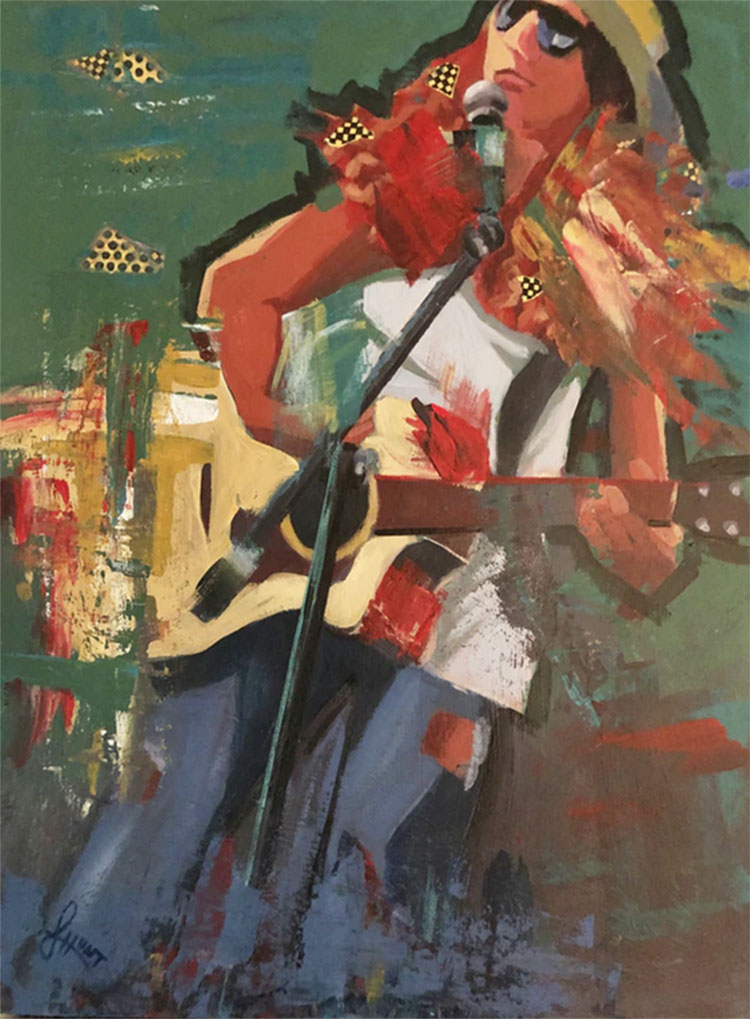 Laura Hunt
Laura Hunt
Good Girls Play Acoustic
Acrylic and collage on wood panel
24 x 18 x 1 5/8 inches
 Laura Hunt
Laura Hunt
The Reach
Acrylic on cradled wood panel
36 x 24 x 2 inches
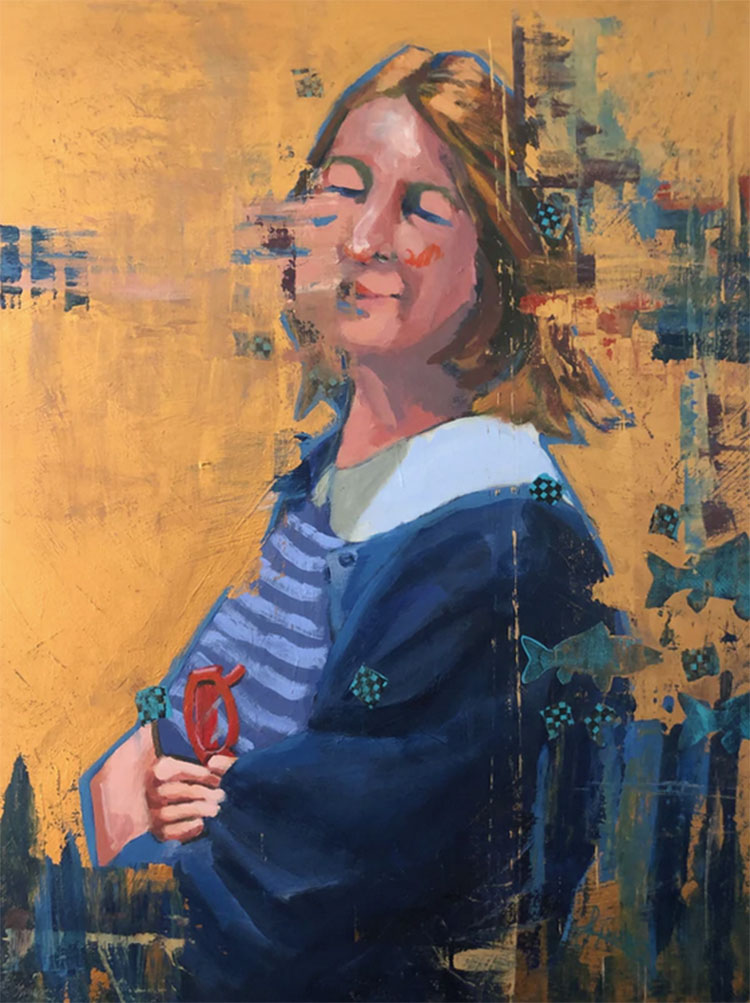 Laura Hunt
Laura Hunt
Woman With Glasses And Fish
Acrylic and collage on cradled wood panel
24 x 18 x 2 inches
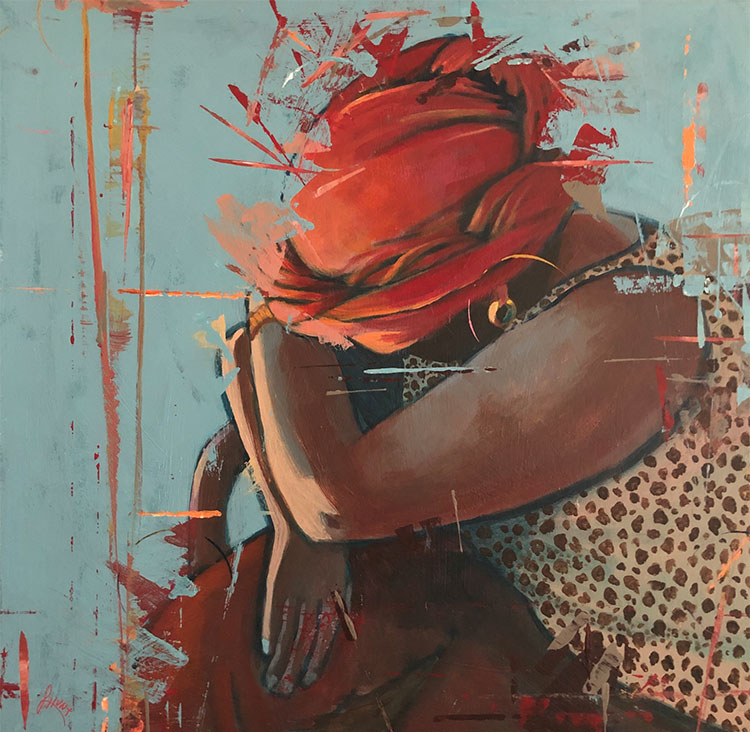 Laura Hunt
Laura Hunt
Woman With Gold Earring
Acrylic on cradled wood panel
24 x 24 inches
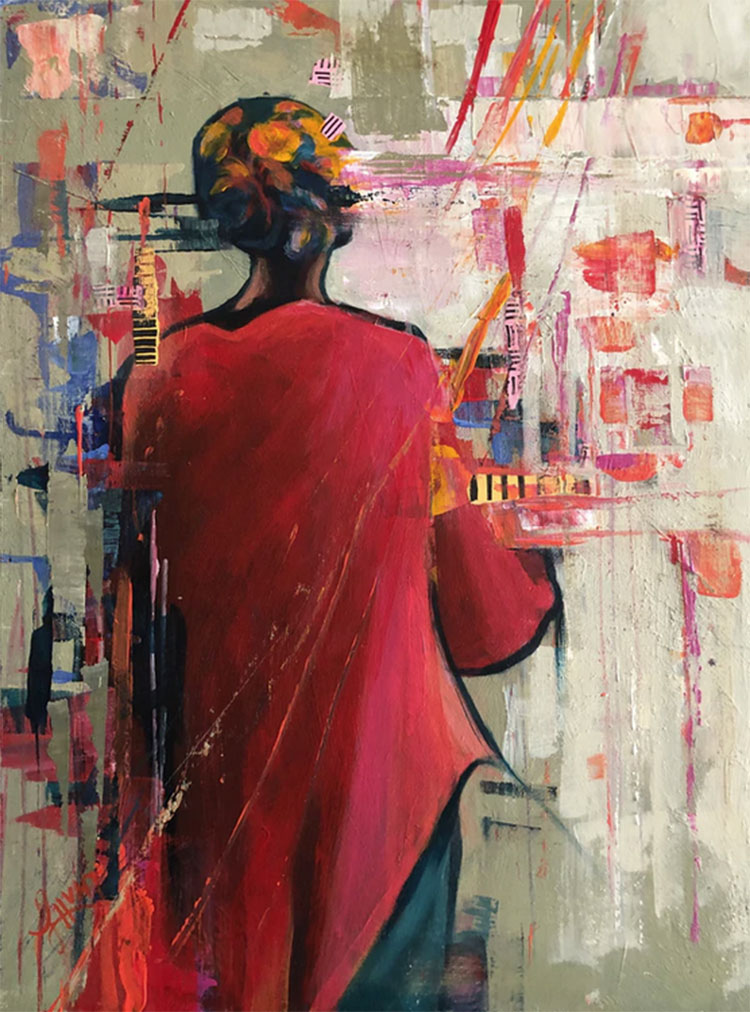 Laura Hunt
Laura Hunt
Woman With Hat And Shawl
Acrylic and collage on cradled wood panel
24 x 18 x 2 inches
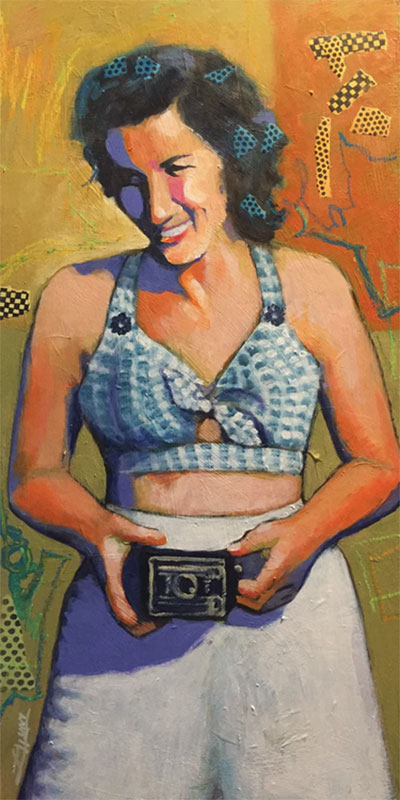 Laura Hunt
Laura Hunt
Before I Knew Her
Acrylic, collage and artist's crayon on cradled wood panel
10 x 20 x .75 inches
Frame size: 22.25 x 12.25 x 1.675 inches
Laura Hunt - Artist
ARTIST STATEMENT
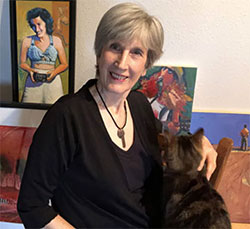
My subject, the human figure, has chosen me. Having gone through stages of interest in
several genres, I always find myself returning to portraits and figures. I’m drawn to the
emotion expressed by the gesture of a hand or the tilt of a head. I’m fascinated by the
divine spark, the infinite variety of the human face, and the tiny differences that make
each of us our unique selves.
Themes of human relationships and emotion, social issues and empathy bind the work together.
Although my work has a naturalistic foundation, I am uninterested in creating academically
perfect figurative work. I prefer a more expressive approach that is less about visual
accuracy and more about the human experience.
It is often the play of light and shadow across the face or the body that first draws me
in. I draw from life in a tiny sketchbook I keep handy to record interesting postures.
Theaters and gatherings provide venues for filling it with drawings of people—from the
back. I rummage through family photos to unearth grainy images of unidentified relatives
and quirky strangers from yore. I’m not above sneaking a snap of someone in a compelling
gesture and adding it to my photo library. Friends pose for photo sessions to further fill
my bank of references. And sometimes pure imagination stimulates the creative process. All
are at play in my search for that certain archetypal human quality to express in a work of
art.
I begin by digitally editing my photographic image, emphasizing contrast and simplifying
shapes. The result becomes my reference. I work with acrylic paint on my favorite surface,
cradled wood panels. I like their crisp corners, and how they feel like containers holding
something mysterious and beautiful. After applying gesso to the panel, I cover it with
orange, turquoise, metallic copper or whatever feels right. That layer influences the
overall presence of the painting, peeking through gaps to energize the work. Patterned
paper scraps or torn vintage maps animate the picture plane. Outlines and the simplification
of details lend a symbolic quality to my figures. And scraping paint right across an almost
completed work is another technique I use to shift the subject from specific individual to
universal archetype.
My influences include anonymous folk and tribal artists of Africa and the Americas, and
the Abstract Expressionists. I deeply admire the figurative works of David Bates for its
bold stylization, David Park for his confident expressiveness, and Catherine Kehoe for
her mastery of simplification of the human figure. When I see their work, I feel affirmed
in my direction as I seek my own version of those ideals.
ARTIST BIO
If Laura Hunt’s career path were predicted only from her early days, one would not have
expected her to become an artist. Her first 17 years were spent on a farm in rural Central
Texas where art education of any kind was a rare if non-existent commodity. She has always
created art somehow, and as most kids do, she drew. At age 16, she responded to a “Draw Me
Talent Test,” an adver-tisement placed in a farm magazine by Art Instruction Schools in
Minneapolis. She drew the simple image in the ad and mailed it to the school. This was how
the school found prospects for their correspondence course in graphic design, so of course,
a salesman paid a visit.
Hunt remembers, “To my surprise, my parents signed me up, an out-of-character decision for
very practical and frugal farmers.” She stuck with it about a year, but struggled to advance
without a hands-on teacher and without an artist role model in sight. She went on to
Tarleton State University to major in English, abandoning her first love—or so she thought.
“During my junior year, everyone in the dorm decorated their doors for Christmas. I
created a silhouetted manger scene, and was floored when I won first prize, a huge tin
of popcorn. That and an art history elective were my only art endeavors during college.
By the time I earned my degree, got married, and had my first child, I had spent about
nine years not nurturing the artist within me. I had taught middle-school English, written
scripts for a multi-media company, and published some poetry, but hadn’t attended to the
part of me that loved image-making.”
The creative urge returned as her little son passed out of the baby stage and entered toddlerhood, giving her a little more time on her hands. She bought a stitchery kit, embroidered her first piece during baby nap time, and was quickly bored with copying the picture on the package. She started embroidering her own designs, selling them at craft fairs in the San Antonio, Texas, area where she lived with her young family.
A workshop in banner-making, led by San Antonio fiber artist and author Becky Patterson, propelled Hunt to a several-year career in textiles. Her hangings made of weathered blue jeans, found objects, old crocheted lace and appliqued fabrics found their way into galleries in Fredericksburg, TX, and Jackson Hole, WY. One of them invited her to be part of a two-artist show.
After a move to Houston, family needs required a second steady paycheck, so she became a production assistant in a printing shop, seeing this as a way to learn graphic design on the job. This step eventually launched a 30-plus year career in graphic design, and marketing consulting, a fortuitous blend of her skills, interests and education.
Following a move to nearby La Porte, TX, and the birth of her second son, she took her first life drawing classes by acclaimed Houston artist, Jose Perez. “The only way to get into the class was to know someone in it who would alert you to an opening. A friend who was taking the class did just that. I was accepted into the class, and became totally smitten with drawing the figure!” She made time for instruction in pastel portraiture as well.
“I even enrolled in classes at University of Houston at Clear Lake with the intent of getting an MFA,” Hunt recalls. “After one semester, the professor, who had seemed doubtful of this non-traditional student, told me ‘You’re on the right track.’” Although a move to Fort Worth cut those plans short, she continued to develop her skills. She entered the commercial world through her cut paper illustrations, working for ad agencies and two different greeting card companies. Eventually the award-winning graphic design and marketing business she had started left little time for her own art.
“No regrets,’ says Hunt. ‘It was a fit for me. And it’s ironic that graphic design was the career that correspondence course was intended to teach me as a teenager.”
2013 brought significant change. Hunt’s beloved husband passed away, and she faced the necessity of reinventing her world. She left her marketing and design career behind to immerse herself into her own art, naming her endeavor SeptemberArt Studio which incorporates her own birth month and that of loved ones. “Thankfully, I had spent over 30 years in the commercial world honing design and business skills that would serve me well as a fine artist.” Hunt says.
Watercolor was her re-entry point. Working small, she expressed her grief and her changed reality on paper. Stamping and collage elements became a part of her developing style. She enrolled in life drawing and watercolor classes, taught by the respected Texas artist Carol Ivey, to refresh her skills and her spirit. As she became more confident, her work grew larger, and began to reflect her positive, hopeful worldview.
As she defined her artistic vision, she began to focus on abstraction, with a growing desire to work larger than watercolor on paper would practically allow. Acrylics on canvas became her new medium of choice, often with the addition of other media—collage, stamping, and even dry wall paste.
Hunt continued to broaden her artistic vocabulary. When she cleaned out her late husband’s wood-working shop in the summer of 2017, not only did the blank slate of space present itself, so did a treasure trove of non-traditional art supplies. She renovated the space and began using it to produce 3-D found object assemblages that expanded her visual expression.
Since the beginning of 2019, Hunt has focused on contemporary figurative painting, which melds her love of abstraction and her interest in the human condition. After several years of creating non-objective abstract work, she responded to the insistent tug at the sleeve to create a new body of work, one that would have at its core the human figure and the universal stories it could tell. They tell of her attempts to understand and explore human relationships and emotion, social issues and empathy. But she didn’t leave abstraction completely behind. It still appears in the ambiguous but vaguely familiar back-grounds that provide her archetypal figures a home. She continues to explore the relationships between painterliness and content, between materials and subject matter.
Describing her process, Hunt explains, “Most of my work begins with a photographic image. It may be a grainy, dusty vintage photo of some long forgotten kin that captures my attention as I rummage through the family archives. At other times I ask friends and relatives to pose for me. And I’m not above some benign stalking when I’m out in public where I may capture a photo of a stranger’s iconic gesture.”
She takes the image into photo editing software, emphasizing contrast and simplifying shapes. The result becomes her reference at the easel—or in the case of digital work, at the iPad.
Cradled wood panels are Hunt’s favorite surfaces for easel painting. “I like their crisp corners, their firmness, and their “object-ness.” She tapes off the wooden edges to save them for staining. After applying gesso, she covers the surface with color—red, orange, turquoise, or whatever feels right for the subject. Even if entirely covered, the first layer influences the overall presence of the painting, peeking through gaps and energizing the work.
Her portraits and figures aim for the emotional, the iconic, the archetypal. She achieves a certain universality through simplification of shapes. The addition of a dark outline flattens the figure and facilitates the shift from individuality to symbolism. At times, she brings in collage elements that add surface interest. ”I’m not interested in capturing a perfect likeness, but rather a relatable mood or emotion,” says Hunt.
Hunt cites many influences that include the folk art of Africa and the Americas, the Abstract Expressionists and the Bay Area Figurative painters. “I’m attracted to paintings of figures that are completely non-academic. Seeing the work of David Bates, Catherine Kehoe and David Park, affirms my direction. Their economy of technique and originality of expression inspire me. I hope to reach a place where I will have my own version of that.”
In 2020, the year of the coronavirus pandemic, Hunt began experimenting with digital art, learning to create figurative work in this new medium. She strives for a painterly look and feel. And although the medium presents opportunities not offered by easel work (and vice versa), her digital art has been mistaken for a traditional painting.
“No matter what medium I use, I strive to create art that stirs something within the viewer, evokes an ache or heals a hurt, and fosters meaningful conversations,” Hunt states when asked about her mission. “Art has the power to express the unspoken longings of the human heart.”
Outside of her studio time, Hunt has varied interests. On her small urban property, Hunt has maximized the use of her courtyard by turning part of it into a vegetable garden, grown in metal tanks designed for feeding livestock, a small reminder of her rural roots. She enjoys cooking with a plant-based emphasis, especially for friends and loved ones. Travel is another interest, especially for the purpose of visiting her children and grandchildren in Colorado and Oregon. And she looks for the opportunity to host the occasional party, including studio events several times a year.
|

